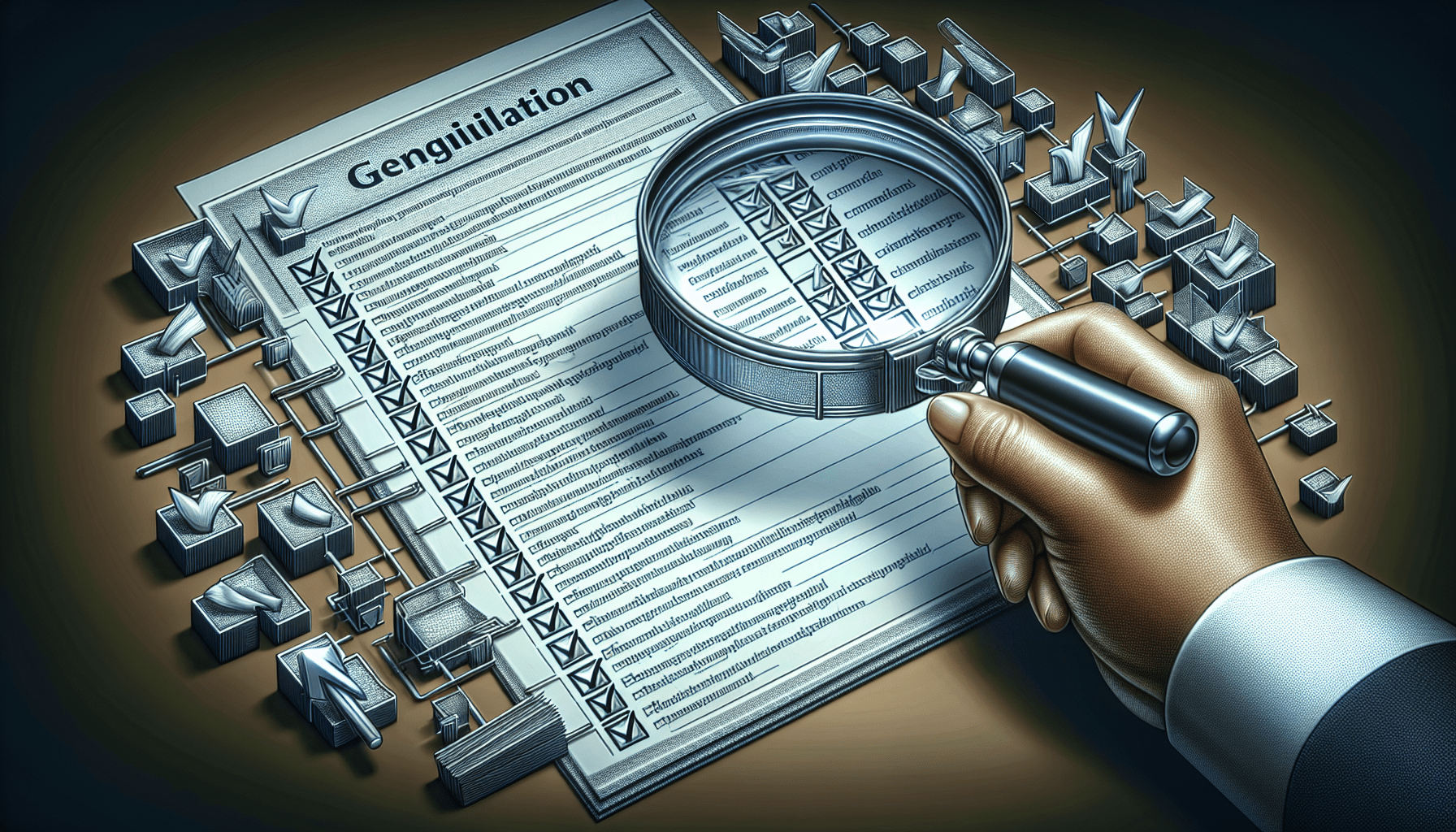In today’s rapidly evolving regulatory landscape, compliance audits have become a critical component for organizations aiming to stay compliant with laws and regulations. Whether you are a business owner, executive, or part of a compliance team, understanding compliance audits is essential for ensuring your organization’s legal and ethical practices. This beginner’s guide will provide you with a comprehensive overview of compliance audits, covering everything from their purpose and process to the importance of maintaining compliance and the potential consequences of non-compliance. By gaining a solid understanding of compliance audits, you will be better equipped to navigate the complex realm of regulatory compliance and protect your organization from legal risks and reputational damage.
What is a Compliance Audit?
A compliance audit is a process that evaluates an organization’s adherence to laws, regulations, and industry standards. It aims to ensure that the organization is operating in accordance with applicable rules and guidelines, mitigating risks, and maintaining ethical conduct. By conducting compliance audits, businesses can identify non-compliance areas, implement corrective measures, and promote a culture of integrity and transparency within their operations.
Definition of Compliance Audit
A compliance audit is an objective and systematic examination of an organization’s policies, procedures, and practices to determine their compliance with legal and regulatory requirements. It involves reviewing documents, conducting interviews, and analyzing data to assess the organization’s adherence to applicable laws, regulations, and industry standards. The ultimate goal of a compliance audit is to identify areas of non-compliance and recommend ways to improve compliance and mitigate risks.
Importance of Compliance Audits
Compliance audits play a crucial role in promoting corporate governance, risk management, and accountability. They are vital to ensure that organizations are operating within the boundaries of the law and industry regulations. Here are some key reasons why compliance audits are important:
-
Risk Mitigation: Compliance audits help organizations identify and mitigate compliance risks. By evaluating adherence to laws and regulations, businesses can proactively address potential violations and minimize the risk of legal and financial consequences.
-
Legal and Regulatory Compliance: Compliance audits ensure that organizations are staying up to date with the latest laws, regulations, and industry standards. This helps businesses avoid penalties, fines, and reputational damage that can result from non-compliance.
-
Ethical Conduct: Compliance audits promote ethical conduct within organizations. By evaluating internal policies and practices, businesses can identify and address any unethical behaviors or practices, fostering a culture of integrity and responsible business conduct.
-
Operational Efficiency: Compliance audits help improve operational efficiency by identifying areas for process improvement and streamlined procedures. By ensuring compliance with regulations, organizations can optimize their processes and minimize operational risks.
Types of Compliance Audits
Compliance audits can vary depending on the scope and focus of the audit. Here are some common types of compliance audits:
-
Financial Compliance Audit: This audit examines an organization’s financial records, policies, and procedures to ensure compliance with accounting standards, tax regulations, and financial reporting requirements.
-
Data Privacy and Security Compliance Audit: This audit assesses an organization’s adherence to data privacy and security regulations, such as the General Data Protection Regulation (GDPR) or the Health Insurance Portability and Accountability Act (HIPAA).
-
Health and Safety Compliance Audit: This audit evaluates an organization’s compliance with health and safety regulations to ensure a safe working environment for employees and customers.
-
Environmental Compliance Audit: This audit focuses on assessing an organization’s compliance with environmental laws and regulations, such as waste management, emissions control, and resource conservation.
-
Labor and Employment Compliance Audit: This audit examines an organization’s compliance with labor laws, employment regulations, and workplace policies to promote fair and equitable treatment of employees.
By understanding the specific type of compliance audit needed, organizations can tailor their auditing procedures to ensure comprehensive assessment and compliance in the respective area.
Preparing for a Compliance Audit
Preparing for a compliance audit is essential to ensure a smooth and successful process. By following these key steps, organizations can be well-prepared and demonstrate their commitment to compliance.
Understanding Applicable Laws and Regulations
To prepare for a compliance audit, it is crucial to have a comprehensive understanding of the relevant laws, regulations, and industry standards that apply to your organization. Conduct thorough research, consult legal experts, and engage compliance professionals to stay updated on any changes or new requirements.
Creating a Compliance Checklist
Developing a compliance checklist is an effective way to ensure that all relevant areas are covered during the audit. The checklist should encompass the specific standards, processes, and documentation that need to be reviewed to assess compliance. By using a systematic approach, organizations can stay organized and conduct a thorough audit.
Ensuring Documentation and Record Keeping
Maintaining accurate and up-to-date documentation is essential for a successful compliance audit. Ensure that all relevant policies, procedures, agreements, and records are properly documented, easily accessible, and properly organized. This includes employee records, financial documents, contracts, and any other documentation relevant to the audit.
Training Staff for Compliance
Compliance is a collective effort, and it is crucial to train staff members on their roles and responsibilities regarding compliance. Provide comprehensive training on relevant laws, regulations, and internal policies to ensure that employees understand their obligations and can actively contribute to compliance efforts.
Conducting Internal Audits
Regularly conducting internal audits can help organizations identify areas of non-compliance and address them proactively. By reviewing internal processes, policies, and procedures, businesses can identify and rectify any compliance gaps before undergoing an external compliance audit. Internal audits also help organizations establish a culture of continuous compliance improvement.

The Compliance Audit Process
The compliance audit process consists of several stages that organizations should be familiar with. By understanding these stages, organizations can navigate the audit process effectively and maximize the benefits of the audit.
Notification and Scheduling
The first step in the compliance audit process is the notification and scheduling of the audit. Typically, auditors will inform the organization in advance about the upcoming audit and mutually agree upon a suitable date and time for the audit to take place. This allows the organization to prepare adequately and gather the necessary documentation for review.
Scope and Objectives
During this stage, the scope and objectives of the audit are defined. The auditors and the organization work together to establish the areas of focus, specific compliance requirements, and regulatory frameworks that the audit will cover. Clearly defining the scope and objectives ensures that the audit is comprehensive and tailored to the organization’s unique compliance needs.
Gathering and Analyzing Data
Once the scope and objectives are established, the auditors proceed with gathering and analyzing data. This includes reviewing documentation, such as policies, procedures, agreements, financial records, and employee files. The auditors assess whether the organization has the necessary controls and processes in place to ensure compliance and identify any areas of potential non-compliance.
Interviews and Document Review
As part of the audit process, auditors may conduct interviews with key personnel and stakeholders within the organization. This allows them to gather additional information, clarify any doubts, and validate the effectiveness of the organization’s compliance efforts. Additionally, auditors may extensively review documents related to compliance, such as incident reports, training records, and compliance documentation.
Identification of Non-Compliance
During the audit, the auditors identify areas of non-compliance. These can be deficiencies in processes, policies, or practices that do not meet the requirements set by applicable laws and regulations. The identification of non-compliance provides organizations with valuable insights into areas that need improvement, allowing them to take corrective actions to address these deficiencies.
Presenting Findings and Recommendations
Upon completion of the audit, the auditors present their findings and recommendations to the organization. This includes a comprehensive report detailing the observed non-compliance areas, their severity, and recommendations for corrective actions. The organization can then review and implement these recommendations to improve compliance and mitigate risks.
Common Areas of Compliance Audits
Compliance audits can cover various areas depending on the industry, nature of the organization, and relevant regulations. Here are some common areas where compliance audits are conducted:
Financial Compliance
Financial compliance audits ensure that organizations are meeting the necessary accounting and financial reporting standards. This includes reviewing financial statements, internal controls, tax compliance, and adherence to relevant accounting principles.
Data Privacy and Security Compliance
In an era of increasing concerns about data breaches and privacy, data privacy and security compliance audits are crucial. These audits assess if organizations are complying with data protection regulations, adequately protecting personal information, and implementing necessary security measures.
Health and Safety Compliance
Health and safety compliance audits focus on assessing whether organizations are providing a safe and healthy work environment for their employees and customers. It includes evaluating compliance with health and safety regulations, the presence of necessary safety protocols, and the effectiveness of risk management systems.
Environmental Compliance
Environmental compliance audits evaluate how organizations are adhering to environmental regulations and standards. They assess factors such as waste management practices, emissions control, resource conservation, and compliance with environmental impact assessments.
Labor and Employment Compliance
Labor and employment compliance audits aim to ensure that organizations comply with labor laws and employment regulations designed to protect workers’ rights. These audits evaluate areas such as wages and benefits, working hours, employment contracts, and compliance with anti-discrimination and harassment laws.

Challenges in Compliance Audits
While compliance audits are essential for organizations, they can present certain challenges that need to be addressed effectively. Here are some common challenges faced during compliance audits:
Complexity of Laws and Regulations
The ever-changing and complex nature of laws and regulations can pose challenges for compliance audits. Organizations need to stay updated with the latest changes in regulations, which may require significant resources and expertise.
Evolving Regulatory Landscape
As new regulations are introduced and existing ones are modified, organizations need to adapt and ensure compliance with the evolving regulatory landscape. This requires continuous monitoring and proactive measures to stay compliant with changing requirements.
Data Security and Confidentiality
Compliance audits often involve the review of sensitive and confidential information. Ensuring data security and confidentiality throughout the audit process is crucial to maintaining trust and protecting the organization’s sensitive information.
Resistance to Change
Implementing compliance recommendations often requires changes within an organization. Resistance to change from employees or stakeholders can pose challenges in effectively addressing non-compliance areas. Organizations need to prioritize change management strategies to overcome resistance and foster a culture of compliance.
Benefits of Compliance Audits
Compliance audits offer several benefits that contribute to the overall success and sustainability of an organization. Here are some key benefits of conducting compliance audits:
Identification of Non-Compliance Risks
By conducting compliance audits, organizations can proactively identify areas of non-compliance and potential risks. This allows them to address issues before they escalate and result in significant legal, financial, or reputational consequences.
Improved Compliance and Risk Management
Compliance audits provide insights into areas that require improvement, enabling organizations to enhance their compliance practices and risk management procedures. By implementing the recommended corrective actions, organizations can ensure better compliance and reduce the likelihood of non-compliance incidents.
Enhanced Reputation and Trust
Organizations that demonstrate a commitment to compliance through regular audits and proactive measures enhance their reputation and build trust with stakeholders. Customers, investors, and business partners are more likely to trust organizations that prioritize compliance and ethical conduct.
Cost Savings and Avoidance of Legal Consequences
By identifying and addressing non-compliance areas, organizations can potentially avoid costly legal consequences, such as fines, penalties, or lawsuits. Compliance audits help organizations assess their compliance status and take corrective actions, thus saving costs associated with non-compliance incidents.
Tips for a Successful Compliance Audit
To ensure a successful compliance audit, organizations should follow these key tips:
Engage Compliance Professionals
Seeking guidance from compliance professionals or external auditors can greatly enhance the effectiveness of a compliance audit. These experts have the knowledge and experience to identify potential compliance risks and offer valuable recommendations for improvement.
Stay Updated with Laws and Regulations
Organizations should stay informed about changes in laws, regulations, and industry standards applicable to their operations. Regularly monitor regulatory updates, engage legal advisors, and invest in ongoing training to keep employees up to date with compliance requirements.
Maintain Good Documentation Practices
Accurate and well-organized documentation is essential for compliance audits. Maintain a centralized repository for all compliance-related documentation, including policies, procedures, records, and audit reports. This ensures easy access and retrieval of necessary information during the audit process.
Provide Adequate Training and Support
Invest in comprehensive training programs for employees to improve their understanding of compliance requirements and expectations. Foster a culture of compliance by providing ongoing support and resources to facilitate compliance efforts throughout the organization.
Implement Continuous Improvement Measures
Compliance is an ongoing process, and organizations should continuously strive for improvement. Regularly review and update compliance-related processes, policies, and systems based on audit findings and emerging best practices. Implement continuous improvement measures to enhance compliance and mitigate risks proactively.
Conclusion
Compliance audits serve as a crucial tool in ensuring that organizations adhere to laws, regulations, and industry standards. By conducting comprehensive audits, organizations can identify areas of non-compliance and proactively address them, promoting ethical conduct, and reducing the risk of legal and financial consequences. Through effective preparation, understanding the compliance audit process, and embracing recommended tips, organizations can ensure successful compliance audits and reap the numerous benefits they offer.



